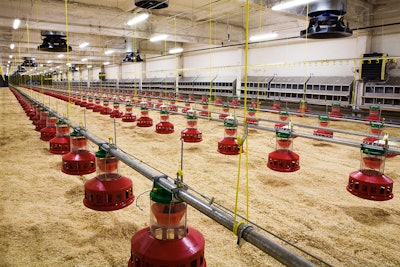
Broiler litter is home to billions of bacteria and most of them are beneficial, however, Salmonella will thrive there if it is not managed properly, University of Arkansas Professor and Poultry Husbandry and Management Extension Specialist Zac Williams, Ph.D., explained at the 2024 Delmarva Chicken Association meeting.
For Salmonella to thrive in poultry litter, it needs moisture, nutrients and an optimal temperature to thrive, and the easiest, and arguably the most important, variable for producers to control of the three is moisture, he added.
Before flock placement
To prevent Salmonella in the litter, producers should remove anything wet, pre heat the house and have adequate air movement before placing a flock.
Pay attention to any caked-up litter under the water lines, he emphasized, and preheat the house to dry out any existing moisture.
“Air movement from proper ventilation is the single best way to dry anything out and manage litter moisture,” Williams said.
During brooding, grow out
Having proper ventilation to keep cool air towards the top of the house, and off the warm floor, will help keep the litter dry during brooding. This includes keeping inlets at the proper opening, which is 1 ½ - 2 inches for sidewall inlets and 1 – 1 ¼ inches for ceiling inlets.
“Ceiling inlets need to be closed more because of the way that air comes into the house. Sidewall inlets are more directed up and along the ceiling already. If you have ceiling inlets, they are going to get aimed at the floor,” he said. “Ceiling inlets need to be closed more to try to aim that air up along the ceiling.”
Proper ventilation also includes managing the static pressure in the house.
“As we heat air up, we will decrease the humidity of the air. For every 10-degree increase, relative humidity drops around 25% because the warmer the air is, the higher its capacity is to carry moisture.”
During grow out, when tunnel ventilation is used, it is important for producers to also focus on wind speed to manage moisture content.
While wind speed will depend on the complex, Williams recommends at least 600 feet per minute down the center of the house. However, producers should be mindful because the edges of the house will have a slower wind speed, which can cause wet litter along the side walls.
Additionally, Williams recommends to not turn on cool pads until around 10 AM, or until the air in the house reaches 85˚F, and to turn them off around 6 PM.
“That's when your humidity and temperature will change. When temperature rises, relative humidity will decrease enough so that the cool cells are not adding extra humidity in that air flowing through the house.”
Water lines can also be a source of moisture in the litter. Water lines should be maintained properly to prevent leaks and turned on to the correct flow rate for the age of the birds.
What’s next for Salmonella control?
To learn more about the challenges and potential solutions for better Salmonella control in the broiler and turkey industries, attend the Poultry Future Panel Discussion: What’s next for Salmonella control in broilers and turkeys?
The panel discussion takes place Wednesday, January 29, from 8-9 a.m. EST at the Georgia World Congress Center during IPPE 2025.
Registration is FREE. For more information, go to https://www.wattglobalmedia.com/events/poultry-future-events/.



















